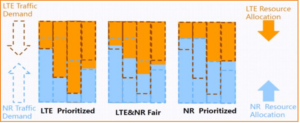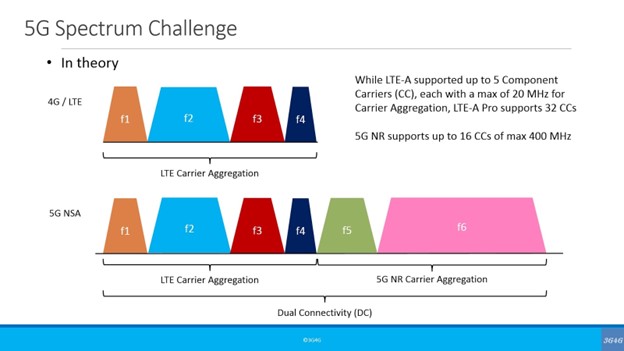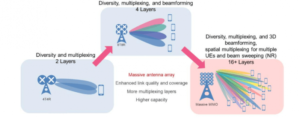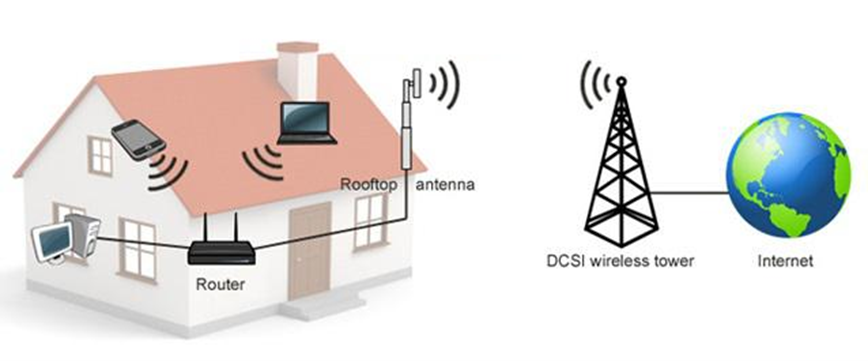 Mobile data demand continues to increase year-over-year and Fifth Generation (5G) systems deliver users high-end performance to meet growing needs. What technologies are helping 5G surpass its 4G predecessor and help consumers and carrier providers alike? The 5 key technologies that enable 5G performance are Dynamic Spectrum Sharing, Carrier Aggregation, Massive MIMO, Fixed Wireless Access (FWA), and access to Millimeter Wave (mmWave) technology.
Mobile data demand continues to increase year-over-year and Fifth Generation (5G) systems deliver users high-end performance to meet growing needs. What technologies are helping 5G surpass its 4G predecessor and help consumers and carrier providers alike? The 5 key technologies that enable 5G performance are Dynamic Spectrum Sharing, Carrier Aggregation, Massive MIMO, Fixed Wireless Access (FWA), and access to Millimeter Wave (mmWave) technology.
Meeting the Increased Demand for Mobile Data
Just how fast is mobile data demand growing? In 2017 Cisco Systems predicted that in 2021, more members of the global population would use mobile phones (5.5 billion) than bank accounts (5.4 billion), running water (5.3 billion), or landlines (2.9 billion. Of course, many mobile phone users own multiple devices or subscriptions. According to Statista, the final 2021 numbers for mobile use came in much higher: at 6.2 billion for global Smartphone subscriptions alone and a whopping 7.1 billion when looking at all mobile devices. Clearly, the demand for mobile data is strong. And in our data-driven world, both consumers and carrier providers have specific requirements they want 5G to support.What consumers want from 5G:
- Faster downlink (DL) and uplink (UL) speeds.
- Higher quality of service (QoS) — service that’s secure and reliable.
- On-demand anything and everything, everywhere — especially when it comes to streaming video.
What wireless carrier providers want from 5G:
- Reduce the cost of transmitted data.
- Keep up with the explosive mobile data demand.
- Look for alternative business models and alternative revenue streams.
- Ultra-low latency network capability.*
5 Key Technologies that enable 5G Performance
Together, 5 key technologies enable the 5G performance required to keep up with increasing demand for mobile data. Today we’ll discuss the performance contributions of Dynamic Spectrum Sharing, Carrier Aggregation, Massive MIMO, Fixed Wireless Access (FWA), and access to Millimeter Wave (mmWave) technology.Dynamic Spectrum Sharing
In wireless communications, frequency spectrum is the number one resource Mobile Network Operators (MNO) require for operation. Government entities auction off pieces of the frequency spectrum to the highest bidder, so each piece must be used effectively and efficiently. The 3GPP Alliance was created in 1998, and its goal is to allow MNOs to manage spectrum allocations dynamically via Dynamic Spectrum Sharing (DSS). DSS is a procedure used to allocate spectrum between air interface standards such as 3G, LTE, or 5G. It reduces spectrum waste and optimizes the end-user experience. Spectrum sharing can unlock spectrum that is underutilized by other adjacent signal carriers and allow that spectrum to be shared with other MNOs that are operating under heavy traffic loads.
Figure 1: Dynamic Spectrum Sharing between LTE and NR traffic Source: What is the Dynamic spectrum sharing – 5gworldpro.com
Carrier Aggregation
The ultimate goal of 5G NR is to actively support licensed, shared, and unlicensed spectrum simultaneously. This support provides efficient use of the limited and expensive spectrum available to all operators. For years, operators have advertised that their network is bigger, better, and has more coverage than their competitors. In reality, most of them share the same network and even the broadcast equipment through a process called Carrier Aggregation (CA). Carrier Aggregation combines multiple MNOs into one data channel to increase data rates throughout the system by optimizing the usage of the available bandwidth. Carrier Aggregation is fundamental to 3G and LTE’s ability to increase the downlink/receive data rates. 5G systems will expand this technology to support up to 16 component carriers. In ideal Carrier Aggregation mode, bit stream coming out of a wireless network will seamlessly address the needs of multiple MNO customers. Figure 2: Adding multiple carrier providers to a single spectrum link
Source: The 3G4G Blog: Carrier Aggregation (CA) and Dual Connectivity (DC)
Figure 2: Adding multiple carrier providers to a single spectrum link
Source: The 3G4G Blog: Carrier Aggregation (CA) and Dual Connectivity (DC)
Massive MIMO
Massive MIMO uses the same concept as a phased antenna array found in radar systems. By altering the phase of an RF signal into an array composed of 16, 23, 64, 128, or more antenna elements, one can focus the RF energy beam. This targeted beamforming focuses the energy on exactly where it needs to be instead of broadcasting the energy in the general sector of the target customer. Beamformed signal technique helps to reduce interference between users in the network and has the potential to deliver a wireless data rate equal to that of a two Gigabit fiber optic connection. This massive MIMO technique also takes advantage of the concept of spatial multiplexing, which delivers multiple parallel streams of data within the same resource block of spectrum. By essentially expanding the total number of virtual channels, massive MIMO increases capacity and data rates without additional towers and spectrum requirements.
Figure 3: The transition from fixed antenna arrays to MIMO Source: Evolution from Mimo To Massive mimo – 5G Training and 5G Certification (5gworldpro.com)
Fixed Wireless Access (FWA)
FWA has very little to do with normal mobile communications because it is not mobile at all. FWA allows internet providers an alternative way to deliver high speed broadband internet services to multiple individual housing units. Normally, RF or fiber optic cables are run to each individual unit. With FWA, a provider simply adds a 5G receiver antenna to the exterior of the house. Then they convert the RF connection link into an internet connection at speed up to 2 Gbits/sec. No physical cables means lower installation and maintenance costs—another benefit of adding a 5G network to the communication system.
Figure 4: Fixed Wireless Access replaces a fiber optic cable running to the house with a wireless link Source: https://www.everythingrf.com/community/what-is-fixed-wireless-access
Millimeter Wave (mmWave)
With the normal mobile broadband wireless spectrum fully utilized, 5G systems look for other, higher frequency bands between 24 and 100GHz to supplement their communicant channels. These higher frequency channels are capable of supporting wider bandwidth and higher data rates with lower latency times. All are good things for faster communications rates. 5G systems effectively offload some of the data communications to these shared or unlicensed spectrum in the mmWave bands to free up spectrum in the normal ranges. However, one problem with using a high frequency range is high propagation loss. Additionally, mmWave signals can easily be blocked by foliage, common building materials, and even the human body. Given these limitations, mmWave deployment will be split to either indoor or outdoor connections only. In other words it will be one or the other, but not both. The PE42545 switch is a 5G mmWave CMOS SOI SP4T switch from pSemi. It delivers super low latency at a switching speed of just 75nS, exceptional power handling and linearity. We recently highlighted it as one of the most innovative products of 2022 because of its unparalleled wideband performance from 9kHz to 67GHz.
Figure 5: The relationship between normal broadband and mmWave frequencies Source: The Emergence of 5G mmWave – Accton Technology
The Future of 5G Wireless Communications
Figure 6 shows the transition to 5G from LTE to NSA and SA. Recent 5G deployments around the world have leveraged this NSA option. The NSA option helps shortcut the system backhaul requirements and significantly accelerates 5G deployment. The MNO uses the existing LTE equipment for backhaul and the additional 5G capability solely for data transmission. Once Stand Alone (SA) 5G systems are fully deployed, they will also use the 5G capability for the backhaul duties.

Figure 6: The transition to 5G from LTE, NSA, & SA Source: Qorvo 5G for Dummies
In conclusion, 5G is the future of wireless communication. Constant improvements to device, system, and network development is helping 5G fully live up to its full potential as the technology solution improves to meet growing data demands. The 5 key technologies that enable 5G performance are DSS, Carrier Aggregation, Massive MIMO, Fixed Wireless Access, and access to mmWave technology. RFMW has everything you need to develop your next 5G solution. Browse 5G solutions available at RFMW. About Leonard Pelletier |
Leonard Pelletier is a Supplier Business Manager at RFMW specializing in high energy, RF power amplifier design, and RF component applications. Mr. Pelletier’s substantial background comes from his experience working for a major RF power semiconductor manufacturer that specializes in LDMOS, GaN and SiGe device technologies where he worked in both design and technical support functions. Author, manager, trainer and public speaker, Mr. Pelletier was personally instrumental in the transition from bipolar devices to the use of LDMOS technology by cellular infrastructure OEMs over 25 years ago. |

